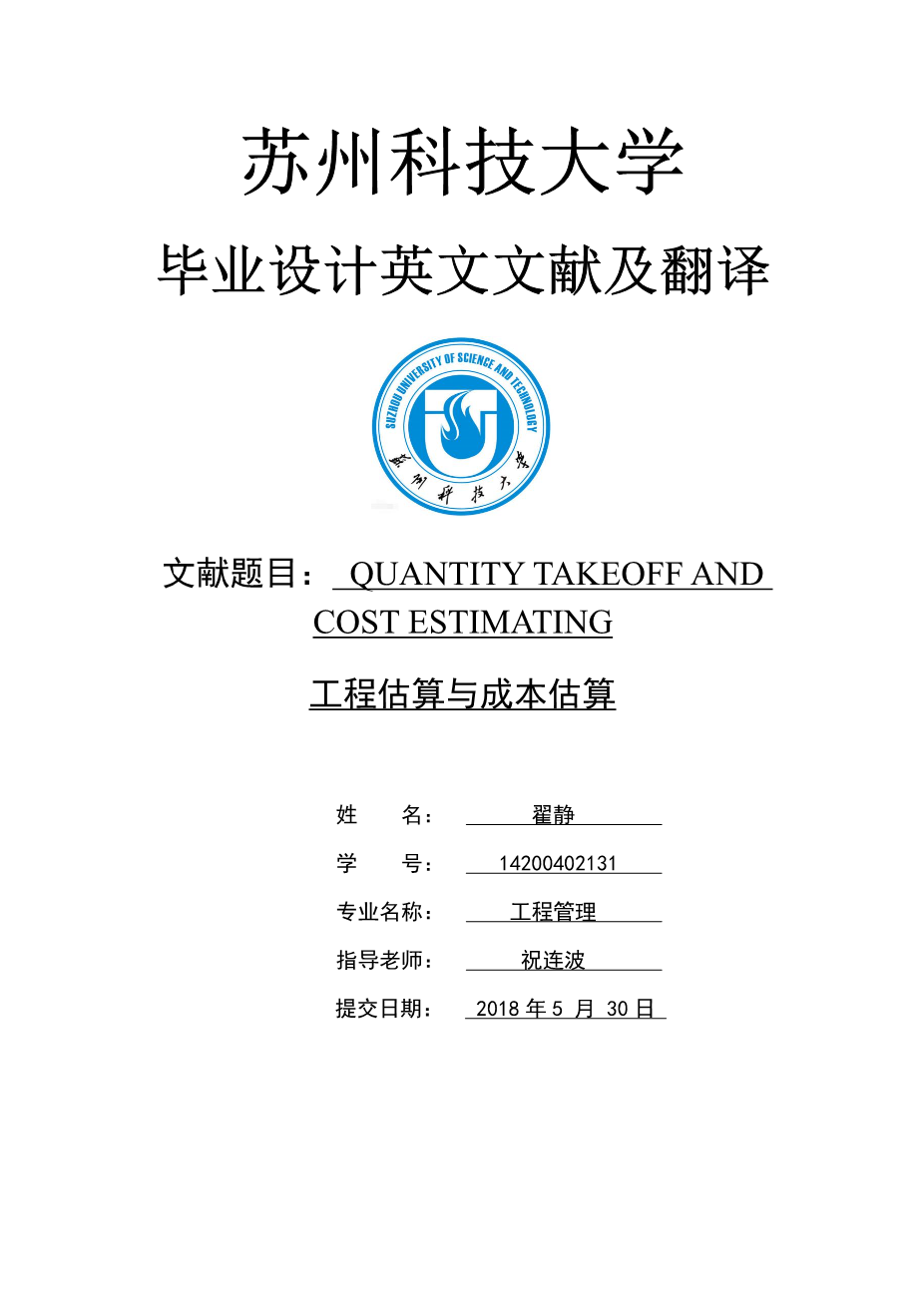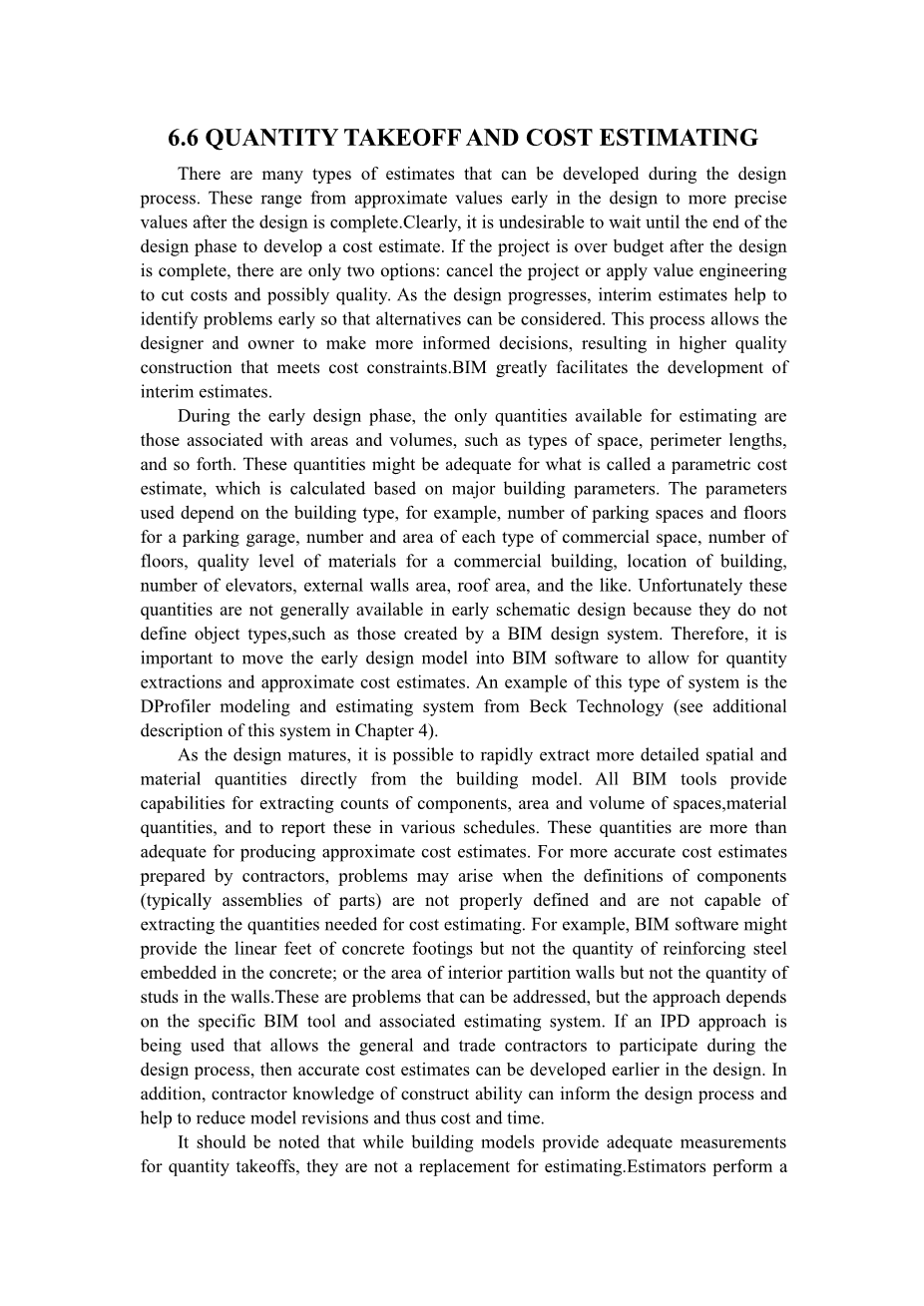苏州科技大学
毕业设计英文文献及翻译
文献题目: QUANTITY TAKEOFF AND COST ESTIMATING
工程估算与成本估算
姓 名: 翟静
学 号: 14200402131
专业名称: 工程管理
指导老师: 祝连波
提交日期: 2018年 月 日
6.6 QUANTITY TAKEOFF AND COST ESTIMATING
There are many types of estimates that can be developed during the design process. These range from approximate values early in the design to more precisevalues after the design is complete.Clearly, it is undesirable to wait until the endof the design phase to develop a costestimate. If the project is over budget afterthe design is complete, there are only two options: cancel the project or applyvalue engineering to cut costs and possibly quality. As the design progresses,interim estimates help to identify problems early so that alternatives can beconsidered. This process allows the designer and owner to make more informeddecisions, resulting in higher quality construction that meets cost constraints.BIM greatly facilitates the development of interim estimates.
During the early design phase, the only quantities available for estimatingare those associated with areas and volumes, such as types of space, perimeterlengths, and so forth. These quantities might be adequate for what is called aparametric cost estimate, which is calculated based on major building parameters. The parameters used depend on the building type, for example, numberof parking spaces and floors for a parking garage, number and area of eachtype of commercial space, number of floors, quality level of materials for acommercial building, location of building, number of elevators, external wallsarea, roof area, and the like. Unfortunately these quantities are not generallyavailable in early schematic design because they do not define object types,such as those created by a BIM design system. Therefore, it is important tomove the early design model into BIM software to allow for quantity extractions and approximate cost estimates. An example of this type of system is theDProfiler modeling and estimating system from Beck Technology (see additional description of this system in Chapter 4).
As the design matures, it is possible to rapidly extract more detailed spatialand material quantities directly from the building model. All BIM tools providecapabilities for extracting counts of components, area and volume of spaces,material quantities, and to report these in various schedules. These quantitiesare more than adequate for producing approximate cost estimates. For moreaccurate cost estimates prepared by contractors, problems may arise whenthe definitions of components (typically assemblies of parts) are not properlydefined and are not capable of extracting the quantities needed for cost estimating. For example, BIM software might provide the linear feet of concretefootings but not the quantity of reinforcing steel embedded in the concrete; orthe area of interior partition walls but not the quantity of studs in the walls.These are problems that can be addressed, but the approach depends on thespecific BIM tool and associated estimating system. If an IPD approach isbeing used that allows the general and trade contractors to participate duringthe design process, then accurate cost estimates can be developed earlier in thedesign. In addition, contractor knowledge of constructability can informthe design process and help to reduce model revisions and thus cost and time.
It should be noted that while building models provide adequate measurements for quantity takeoffs, they are not a replacement for estimating.Estimators perform a critical role in the building process far beyond that ofextracting counts and measurements. The process of estimating involves assessing conditions in the project that impact cost, such as unusual wall conditions,unique assemblies, and difficult access conditions. Automatic identification ofthese conditions by any BIM tool is not yet feasible. Estimators should considerusing BIM technology to facilitate the laborious task of quantity takeoff andto quickly visualize, identify, and assess conditions, and provide more time forconstructability reviews and to optimize prices from subcontractors and suppliers. A detailed building model is a risk-mitigation tool for estimators thatcan significantly reduce bid costs, because it reduces the uncertainty associatedwith material quantities. The One Island East Office Tower and the SutterMedical Center case studies in Chapter 9 provide excellent examples of this.
Estimators use a variety of options to leverage BIM for quantity takeoffand to support the estimating process. No BIM tool provides the full capabilities of a spreadsheet or estimating package, so estimators must identify amethod that works best for their specific estimating process. Three primaryoptions are:
1. Export building object quantities to estimating software
2. Link the BIM tool directly to the estimating software
3. Use a BIM quantity takeofftool
Each of these options is discussed in detail below.
6.6.1 Export Quantities to Estimating Software
As previously noted, most BIM tools offered by software vendors include features for extracting and quantifying BIM component properties. These featuresalso include tools to export quantity data to a spreadsheet or an external data-base. In the United States alone, there are over 100 commercial estimatingpackages and many are specific to the type of work estimated. However, surveys have shown that MS Excel is the most commonly used estimating tool(Sawyer andGrogan 2002). For many estimators, the capability to extract andassociate quantity takeoff data using custom Excel spreadsheets is often sufficient. This approach, however, may require significant setup and adoption of astandardized modeling process. To go beyond the use of Excel, one of the foll
剩余内容已隐藏,支付完成后下载完整资料


英语译文共 8 页,剩余内容已隐藏,支付完成后下载完整资料
资料编号:[469135],资料为PDF文档或Word文档,PDF文档可免费转换为Word
以上是毕业论文外文翻译,课题毕业论文、任务书、文献综述、开题报告、程序设计、图纸设计等资料可联系客服协助查找。


